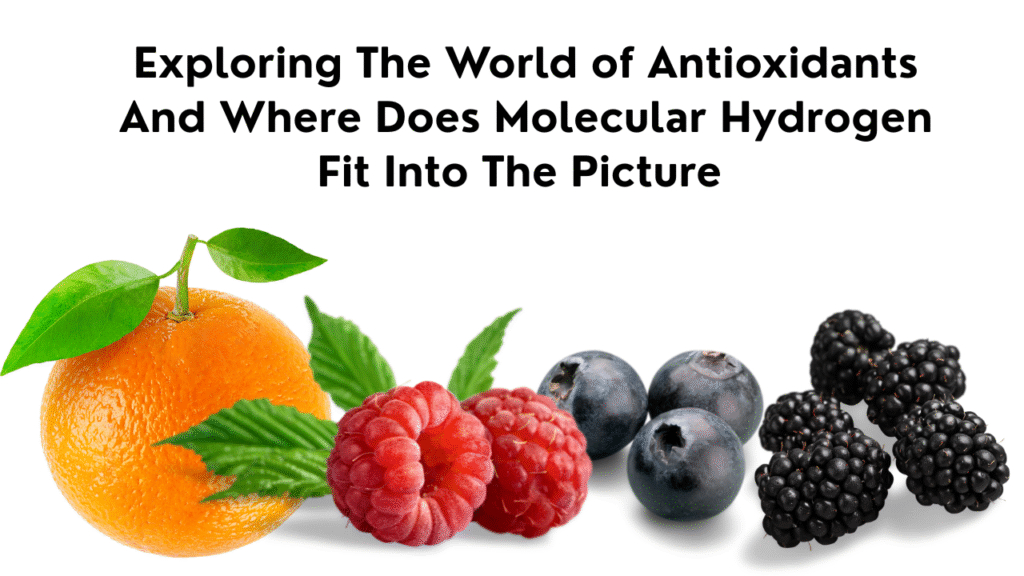Understanding Categories and Unique Properties
Antioxidants are a hot topic in the world of health and wellness, and for good reason. They play a crucial role in protecting our bodies from damage caused by free radicals, unstable molecules that can harm cells and contribute to aging and disease. But did you know that there isn’t just one type of antioxidant? In fact, there are hundreds, even thousands, each with its own unique properties and mechanisms.
This blog post will explore the diverse world of antioxidants, covering their main classifications and highlighting the unique benefits of molecular hydrogen as a novel antioxidant.
Categorizing Antioxidants: A Quick Guide
Antioxidants can be categorized in several ways, based on their origin, solubility, and mechanism of action. Let’s take a closer look at each category:
1. By Origin: Endogenous vs. Exogenous
- Endogenous Antioxidants are produced naturally within the body. Examples include enzymes like superoxide dismutase (SOD), catalase, and glutathione peroxidase. These enzymes are part of the body’s defense system and work to neutralize free radicals.
- Exogenous Antioxidants come from external sources, primarily through our diet. These include vitamins (like vitamin C and vitamin E), minerals (like selenium), and phytonutrients (plant-based compounds like flavonoids and carotenoids). A diet rich in fruits, vegetables, and whole grains provides a wide array of exogenous antioxidants.
2. By Solubility: Water-Soluble vs. Fat-Soluble
- Water-Soluble Antioxidants dissolve in water and work primarily in the watery environments inside and outside cells. Vitamin C is a prime example, protecting cells and body fluids from oxidative damage.
- Fat-Soluble Antioxidants dissolve in fats and oils and are particularly effective at protecting cell membranes, which are primarily made of lipids. Vitamin E is a key fat-soluble antioxidant that safeguards cell membranes from lipid peroxidation (damage to lipids by free radicals).
3. By Mechanism: Enzymatic vs. Non-Enzymatic
- Enzymatic Antioxidants are enzymes that catalyze (speed up) reactions to neutralize free radicals. As mentioned earlier, SOD, catalase, and glutathione peroxidase are key examples. These enzymes often require minerals like selenium, zinc, copper, and manganese to function properly.
- Non-Enzymatic Antioxidants directly react with and neutralize free radicals without enzymatic assistance. These include vitamins, minerals, and phytonutrients that donate electrons to stabilize free radicals.
Molecular Hydrogen: A Unique Antioxidant
Molecular hydrogen (H2), also known as dihydrogen, is gaining recognition as a novel and unique antioxidant with several distinct advantages.
How it works:
Molecular hydrogen acts as a selective antioxidant, meaning it targets only the most harmful free radicals, such as the hydroxyl radical (•OH), while leaving beneficial free radicals (like nitric oxide) intact. This selectivity is important because some free radicals play vital roles in cell signaling and immune function.
Key Differences:
- Selectivity: Unlike some antioxidants that neutralize all free radicals, molecular hydrogen’s selectivity minimizes disruption to important biological processes.
- Small Size and Bioavailability: Molecular hydrogen is the smallest molecule in the universe, allowing it to easily penetrate cell membranes and even cross the blood-brain barrier, providing antioxidant protection to all tissues and organs.
- By products: When molecular hydrogen neutralizes free radicals, it produces water (H2O) as a byproduct, which is naturally hydrating and harmless to the body.
- Ease of Administration: Molecular hydrogen can be administered in various ways, including drinking hydrogen-rich water, inhaling hydrogen gas, or taking hydrogen tablets, making it accessible and convenient.
The antioxidant world is vast and varied, with each type playing a unique role in protecting our health. Molecular hydrogen stands out as a novel antioxidant due to its selectivity, bioavailability, and ease of use. As research continues to unfold, it’s clear that incorporating a variety of antioxidants into your lifestyle can support overall well-being and help combat the damaging effects of free radicals.


